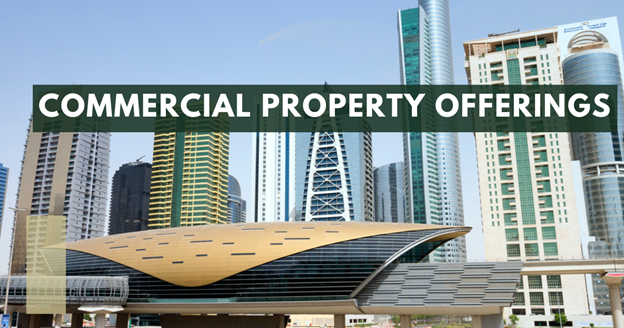JLT Commercial Area Guide
JLT rewards decisiveness. Two Red Line stations, E11 frontage, and 80‑plus clusters convert visibility into deal‑flow. Offices here remain liquid, with competitive yields of up to 9.07% and steady SME absorption.
As Chestertons MENA, we guide leasing and acquisitions that shorten time‑to‑operate and protect NOI.
This guide covers everything about JLT, from location and connectivity, the business ecosystem, commercial offerings, lease norms, to investment appeal with practical ROI drivers. You will also learn about key amenities that support client hosting and workforce access.
So use this simple pathway to select clusters, negotiate terms, and plan fit‑outs with our advisors. As the goal is straightforward: secure the right space at the right risk.
Location and connectivity
Anchored by DMCC, JLT is a mature mixed‑use free zone arranged around three lakes with 80‑plus clusters along a metro‑served Sheikh Zayed Road corridor.
JLT is located at the Front of E11 between Dubai Marina and Jumeirah Beach Residencies Islands, links quickly to TECOM, SZR (Sheikh Zayed Road), and nearby business districts, supporting client access and regional coverage.
Two Red Line metro stations, RTA bus routes, tram, and immediate Sheikh Zayed Road entry/exit ZR ingress/egress underpin reliable commuting and last‑mile logistics for teams and visitors.
Its It’s proximity to Al Maktoum International and Jebel Ali Port adds regional reach for trading, logistics, and supplier networks.
Its central location also places it within 15–20 minutes of Downtown Dubai, Business Bay, and Dubai International Airport, offering convenient access to the city’s major commercial hubs.
Parking and Circulation
JLT offers cluster‑based podium parking which enables predictable allocations for tenants, with visitor bays and controlled access improving client hosting, deliveries, and shift changes.
Ground‑floor operators should evaluate loading access windows, refuse points, and internal circulation to keep delivery times and back‑of‑house movement efficient.
Explore the full picture in “Understanding Dubai’s Warehouse Investment Landscape – Chestertons MENA” for clear, practical takeaways on demand, infrastructure, and returns.
Business Ecosystem
The tenant mix spans SMEs, professional services, regulated fintech/crypto, consultancies, trading houses, F&B operators, wellness/medical clinics, and boutique HQs, creating diverse demand and resilient footfall.
DMCC licensing covers a broad range of activities, while onshore structures coexist nearby to accommodate hybrid, serviced, or flex teams.
Bank branches, corporate services, accelerators, and community events deepen B2B deal‑flow and shorten vendor search costs.
| Aspect | Evidence | Why it matters |
| Company formation | 1,100+ firms added H1‑2025; ~26,000 members (DMCC) | Deep pipeline of occupiers and vendors |
| Crypto/fintech depth | 700+ crypto firms; 38% YoY growth (DMCC) | Regulated innovation attracts capital and talent |
| Sector ecosystems | 3,500+ energy‑related members (DMCC fact sheet) | Cross‑trade synergies drive B2B deal‑flow |
| Transaction liquidity | 85 JLT office sales; avg AED 1,878/sq ft (Aug‑2025) | Active secondary market supports exits |
| Free‑zone advantages | 100% ownership, streamlined setup (Bayut overview) | Faster licensing for flex and hybrid teams |
Read our latest blog: “Complete Guide to Investing in Commercial Property in Dubai – Chestertons MENA” to turn DIC insights into an action plan.

Commercial Property Offerings
Grade A towers in JLT feature efficient floor plates, modern mechanical, electrical, and plumbing (MEP) systems, and floor-to-ceiling glazing. Grade B offices provide a more cost-effective alternative with potential for refurbishment and value improvement.
Available configurations include full floors, half floors, SME-sized suites, and options delivered as shell-and-core, Category A (CAT A), or fitted space—allowing tenants to align occupancy with their timeline and capital expenditure preferences.
Serviced and flexible office centres offer short-term licenses, bundled facilities, and fully furnished suites—ideal for businesses entering the market or setting up project-based teams.
| Offering name | Typical specs | Suitability |
| Grade‑A offices | Efficient plates, modern MEP, floor‑to‑ceiling glazing | Corporate HQs, regional hubs |
| Grade‑B offices | Flexible plates, refurbishment upside, cost control | SMEs, value‑seekers |
| Fitted offices | CAT A or fitted/part‑fitted, immediate occupancy | Fast movers, scale teams |
| Shell‑and‑core | Customisable, longer fit‑out windows | Brand‑specific layouts |
| Serviced/flex suites | Bundled services, short terms, plug‑and‑play | Market entry, project teams |
| Retail/F&B units | Promenade frontage, grease trap/exhaust options | Cafés, QSR, clinics, pharmacies |
Read our latest blog: “Investing in Dubai’s Commercial Real Estate: Market Trends & Opportunities (2025) – Chestertons MENA”
Retail and F&B
Promenade‑facing units and cluster frontages suit cafés, QSR, clinics, pharmacies, and service retail that benefit from commuter and lunchtime footfall.
Key checks include grease traps, exhaust capacity, outdoor seating permits, delivery flows, and visibility/signage rights for durable trade.
Specialty and Ancillary
Medical and wellness units align with healthcare licensing pathways, while training centres and light showrooms can operate where permitted by building and activity code.
Such uses capture weekday demand and complement office rhythms.
Lease Norms and Deal Terms
SMEs often sign one to three‑year leases; corporates favour three to five years with indexation clauses and agreed fit‑out periods.
Leasing norms and cost can involve security deposits, parking allocations, and signage rules, while sub‑leasing restrictions vary by tower and license type.
Investment Appeal
Demand in Jumeirah Lake Towers (JLT) is supported by metro access, a vibrant mixed-use environment, plentiful amenities, and lower entry prices compared with prime Central Business District locations, leading to steady leasing activity. Strata-titled offices and selected retail units offer attractive returns, with opportunities to add value through re-letting, repositioning, or upgrades to building systems.
This combination of strong demand and value-enhancing opportunities underpins the market’s robust performance and investor confidence.
The market has strong liquidity, active secondary trading, and a diversified occupier base, delivering yields of 6–8% and potential returns on investment of up to 9%.
| Metric (2025) | JLT figure | Why it matters |
| Net rental yield | 7.0%–8.5% strata offices; 8%–10% select retail | Income resilience versus prime CBD compression |
| ROI (5‑year, unlevered) | 35%–45% base case with stable occupancy | Blends yield plus moderated capital appreciation |
Amenities and services
Lakeside promenades, cafés, gyms, clinics, hotels, nurseries, and daily‑needs retail, etc. amenities work together to support retention, candidate attraction, and client hospitality on short notice.
Banks, exchange houses, document clearing, and courier access streamline operations and reduce downtime for SMEs and regional hubs.
Walkable public realm and event‑friendly spaces enable brand activations and community engagement.
| Category | Examples | Business value |
| Lakeside & public realm | Promenades, event‑friendly plazas | Client hosting, brand activations |
| Daily needs | Cafés, gyms, clinics, nurseries, hotels | Workforce retention, meeting readiness |
| Corporate services | Banks, exchange houses, document clearing | Faster onboarding, reduced downtime |
| Logistics access | Courier hubs, scheduled deliveries | Reliable last‑mile, smoother SLAs |
Also, read our latest blog: “Best Places to Invest in Commercial Property in Dubai – Chestertons MENA”.
Who should consider JLT?
- SMEs and professional firms prioritising metro proximity, client access, and cost‑effective Grade‑B/Grade‑A options will find adaptable footprints and competitive terms.
- Regional sales hubs and boutique HQs can scale through fitted floors or flex suites with minimal disruption and predictable op‑ex.
- Private and institutional investors seeking income stability and value‑add in strata offices and ground‑floor retail will benefit from depth and velocity.
Conclusion
Jumeirah Lake Towers (JLT) offers clear commercial advantages: metro access, flexible leasing, and market depth that keeps income steady, with capital expenditure enhancing efficiency. It provides a practical, well-connected alternative to premium Central Business District locations without compromising visibility or client reach.
At Chestertons MENA, we turn location, fit-out, and lease decisions into reliable Net Operating Income. Book a consultation with our Commercial Advisory Experts for cluster-by-cluster property selection, lease negotiation, fit-out planning, and income-focused acquisitions in JLT.
We align space, exposure, and timelines with your budget and growth plans, then manage execution to reduce risk. The result is simple and measurable: the right space, the right terms, and a foundation for scalable performance.
FAQs
Is JLT a good area in Dubai?
Yes—JLT combines metro access, Sheikh Zayed Road frontage, and mixed‑use density, which strengthens daily footfall, B2B connectivity, and occupier liquidity for offices and retail across cycles.
How many commercial towers are in JLT?
JLT comprises 80‑plus mixed‑use clusters containing numerous office and retail towers, with Grade‑A/B options spanning full floors to SME suites and serviced centres across the district.
Is JLT a good area to invest in?
For strata offices and select ground‑floor retail, JLT offers competitive yields, active secondary trades, and value‑add potential via re‑letting, re‑positioning, and targeted ESG‑aligned capex.
Is JLT a freehold or leasehold?
JLT operates as a DMCC‑anchored free zone with strata ownership available in many buildings, enabling investor acquisitions alongside flexible licensing for operating companies.
By Chestertons
- Read time
- 5 minutes
